We all want to achieve an excellent cement job every time, we pride ourselves in achieving this. can face a common challenge while attempting zonal isolation during primary cementing: the resulting lack of “good bond” – as measured with cement logs – across permeable zones. This is typically seen as a sudden decrease in cement presence (an increase in CBL amplitude or decrease in Attenuation in sonic logs or a clearer image, maybe some green or even red, in ultrasonic logs) overlapping with lower gamma-ray readings or micro-fracture formations.
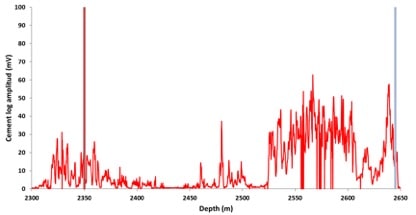
The problem becomes more significant and challenging to address when coinciding with a depleted formation or sub-normal formation pressure. This degree of depletion will be leading to the higher differential pressure between the cement slurry and the pore pressure, as can be seen in the chart below.
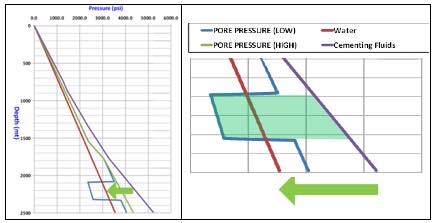
From a well cementing point of view, the combined effect of higher differential pressure and permeability will cause additional fluid loss from the cement slurry (cement filtrate) into the porous media compared to other formations above and below.
This additional amount of cement filtrate (fluid leaving the cement slurry’s constituents) to the formation creates a reduction in volume (cement available to fill the annular space), eventually leading to less cement once set due to bulk shrinkage. In other words, the cement becomes denser (density = mass/volume) or the same solids with the less liquid phase, reducing the volume each “mass” of set cement occupies.
This process will occur locally and predominantly in front of the permeable zone, and the longer/thicker the permeable zone interval, the more damaging the effect.
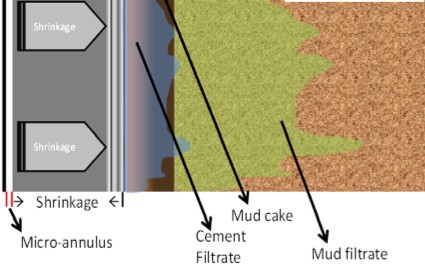
This volume reduction in the cement can induce radial cracks forming once the cement is set. In simpler terms, as there is insufficient cement to fill the annular space, the cement sets in tension being “pull” circumferentially, leading to cracks parallel to the casing extending from the casing to the formation across the cement.
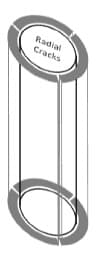
In logs, this can be seen similar to the lack of or poor casing-cement bonding or micro-annulus signature (high amplitude in CBL vs clear formation arrivals in VDL). Still, the main difference is the clarity of the formation arrivals in the VDL. In the presence of radial cracks induced by bulk loss of cement filtrate, the images of formation arrivals, if present, will be less noticeable or weaker; this is because of the combined presence of inner (casing-cement) and outer (cement-formation) micro-annulus.
Now, the big questions…
- Can we still get an excellent cement job?
- Is this lack of bond remediable?
- Is squeeze cementing attainable?
- More profoundly, is zonal isolation in jeopardy?
Most importantly, the answer is YES to the last question; zonal isolation is jeopardized, but this is not easily correctable.
Why? Because every time, during a squeeze cementing operation, the casing, or a portion of it, is pressurized, and any micro annulus will tend to close. That forces the fluid inside out, limiting the space for the further flow of fluids away (both occupying fluids and squeezed cement slurry filtrate).
Factors that can increase the success rate are perforating density and phasing, not shot penetration or diameter. Penetration and shot diameter would increase the injectivity but not favor injection or flow to the affected area in the annular gap.
More importantly, why remediate (perforated casing + squeeze = possible casing leak in the future) if “bulk loss of cement filtrate in from permeable zones” can be prevented? Yes, this situation is preventable, leading to an OK cement log the first and only time. This must be the objective.
Information about the possibility of this problem usually comes from the well design process. The more professional ones incorporate it in the risk register, or well construction (most common drilling) challenges table. The cement engineer should include formal elements to the cement slurry and cement placement process with this information.
The accuracy of the proposed design elements to the job scheme will be determined by “experience.” Either the experience of the engineer or collective expertise in the area.
In other words, previous experience in the form of the engineer’s experience in different locations around the world or joint team experience in the same location because of previous similar failures (the problem has been happening for some time already).
Did you learn a new barrier to an excellent cement job result? In a later post, we will discuss the slurry and job design to overcome this problem and get the best cement log right from the first time.
Cheers
L. Diaz
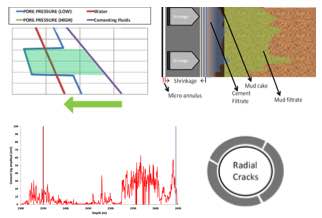

Hi Lenin,
In such permeable zone I have had results with API low fluid loss <30ml. it maybe costly for the operator but the chances of success are much greater.
Else reduce the Slurry TT to the minimum acceptable by Company policy. Why not using expanding agent to overcome the potential micro annulus (can be use only in the slurry to be placed in from of the permeable zone).
rgds
Jean
Hi Jean, thanks for your comment and interest in well cementing.
That is correct, a way to mitigate formation interaction is a very low fluid loss and the use of expanding agent; like any mitigation measure, success is not ensured and likely producing a range of results from no effect to an actual improvement in cement bond. Another cheaper way to mitigate this phenomenon is to increase the slurry density, from 15.8 ppg to 16-16.2 ppg for example, keeping a low fluid loss of around 50 ml/30min (easily achievable with dispersant + fluid loss). Ideally, the fluid loss additive quantity should be as low as possible, since now the slurry is water-reduced the amount of dispersant is optimised giving a low fluid loss of filtrate, then the fluid loss additive is added to take it to 50 ml/30min. The benefits are mainly a cheaper slurry with better mechanical properties less susceptible to formation interaction, less radial cracks and increase visibility on a cement bond log overall.
One of the problems, with very low fluid loss slurries like you mention is the negative effect on compressive strength making the slurry more sensitive to contamination, a negative effect that can hide or overpower any potential benefit from the lower filtrate in terms of cement log visibility.
Any question please let me know
Cheers
L. Diaz
Hi Lenin,
In such permeable zone I have had results with API low fluid loss <30ml. it maybe costly for the operator but the chances of success are much greater.
Else reduce the Slurry TT to the minimum acceptable by Company policy. Why not using expanding agent to overcome the potential micro annulus (can be use only in the slurry to be placed in from of the permeable zone).
rgds
Jean
Hi Jean, thanks for your comment and interest in well cementing.
That is correct, a way to mitigate formation interaction is a very low fluid loss and the use of expanding agent; like any mitigation measure, success is not ensured and likely producing a range of results from no effect to an actual improvement in cement bond. Another cheaper way to mitigate this phenomenon is to increase the slurry density, from 15.8 ppg to 16-16.2 ppg for example, keeping a low fluid loss of around 50 ml/30min (easily achievable with dispersant + fluid loss). Ideally, the fluid loss additive quantity should be as low as possible, since now the slurry is water-reduced the amount of dispersant is optimised giving a low fluid loss of filtrate, then the fluid loss additive is added to take it to 50 ml/30min. The benefits are mainly a cheaper slurry with better mechanical properties less susceptible to formation interaction, less radial cracks and increase visibility on a cement bond log overall.
One of the problems, with very low fluid loss slurries like you mention is the negative effect on compressive strength making the slurry more sensitive to contamination, a negative effect that can hide or overpower any potential benefit from the lower filtrate in terms of cement log visibility.
Any question please let me know
Cheers
L. Diaz